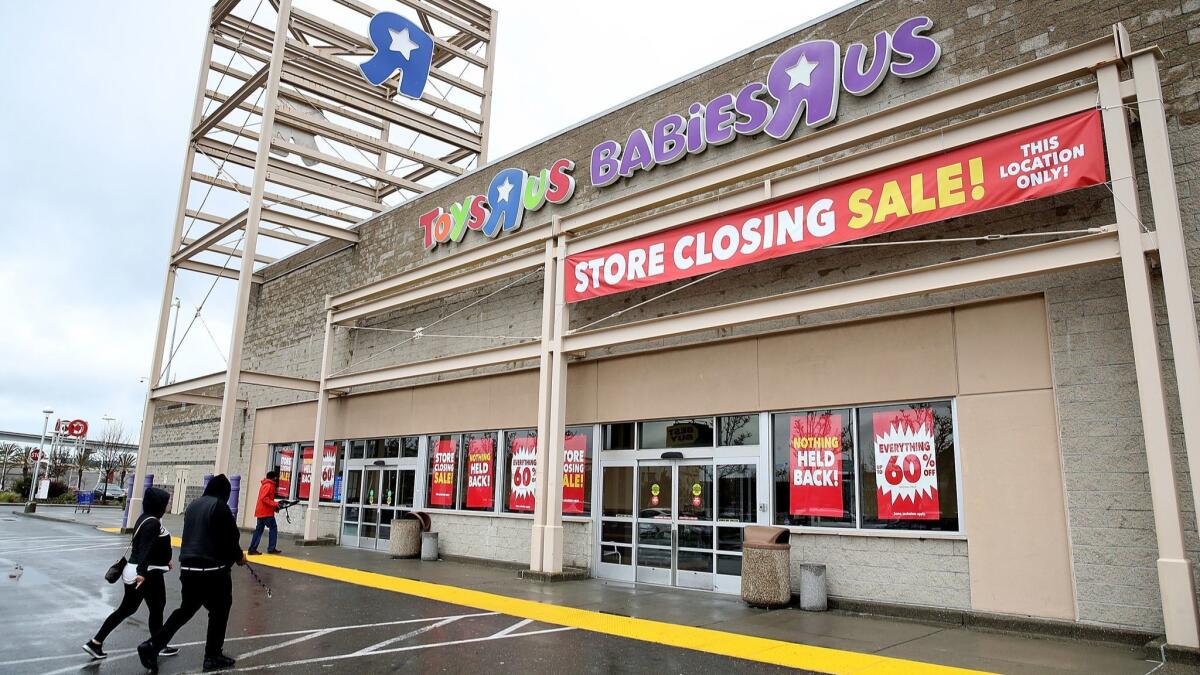Four tips to navigating store liquidation sales

- Share via
The liquidation of Toys R Us is adding to the clutter of “Store Closing” signs as department stores, mall chains and other retailers close poorly performing locations.
But beware. Liquidation sales may sound like a deal-hunter’s dream, but they don’t always offer the best discounts. Shoppers need to compare prices as they navigate the sales racks, and carefully check the quality of the merchandise since they can’t return items.
“Not everything is a great deal,” said Jerry Robertson, a San Antonio-based store closing consultant who manages the liquidation sales of small retailers. “Just be careful of what you buy. Do your homework.”
Shoppers also need to understand the store’s policy of redeeming gift cards. When stores go into bankruptcy, they petition the court to decide whether gift cards can be honored — and for how long, said Shelly Hunter, a representative of Giftcards.com, which has tracked gifts cards from stores such as Borders and Coldwater Creek in bankruptcy.
Toys R Us honored gift cards while it was trying to reorganize under bankruptcy protection. But after the chain said it would liquidate its remaining 735 U.S. stores last week, it says that the cards will be worthless after 30 days.
Here are four tips that shoppers should follow:
Check out prices before the sale
The goal for liquidators is to squeeze as much money they can from a sale. Robertson said many liquidators, particular those who manage sales of big chains, increase the prices to the manufacturers’ suggested level and then take a discount. That creates the illusion of a better deal. So checking out prices before and after the actual liquidation sale starts is a good idea.
Use price-comparison apps
Robertson said most of the big liquidators start at about a 20% discount and lower prices from there. Shoppers should keep checking the store being liquidated to keep track of the discounts. But if they wait too long, they might not get the best selection, he said. Robertson said bigger discounts can be found on clothing and toys, which have larger profit margins. In comparison, consumer electronics have razor-thin margins.
Lindsay Sakraida, director of content marketing at DealNews.com, a price comparison website, said shoppers shouldn’t buy impulsively when they see a big liquidation sign. “These `Everything Must Go’ signs make you have a sense of immediacy,” she said. “Take a minute.”
Use gift cards immediately
When shoppers have gift cards from a store that’s in financial trouble, experts recommend using them immediately. Hunter points to when Borders shuttered its stores in 2011. The courts initially acknowledged that gift card holders were due a settlement, but it didn’t tell them to file claims. So when the deadline passed, the courts ultimately ruled it was too late to file a claim.
And gadget seller Sharper Image stopped accepting gift cards when it filed for Chapter 11 bankruptcy in 2008. A month later, it said they would be accepted only if the holder spent double the value of the gift card in redeeming it. That resulted in a class-action suit, which the company ended up settling. Sharper Image, which shut its stores, has been revived and now sells gadgets online.
Shoppers should beware that when a new buyer comes on board and buys a company in bankruptcy, gift card holders are often left in the cold. That’s what happened with Coldwater Creek. After private equity firm Sycamore Partners, which owns such brands as Talbots, bought the brand in 2014 and relaunched the website, the gift cards became useless.
Examine merchandise carefully
Liquidation sales generally last five to seven weeks and most often sales are final. Toys R Us said that shoppers can’t return items once the liquidation begins. So shoppers should scrutinize their items to make sure there are no defects.
More to Read
Inside the business of entertainment
The Wide Shot brings you news, analysis and insights on everything from streaming wars to production — and what it all means for the future.
You may occasionally receive promotional content from the Los Angeles Times.









